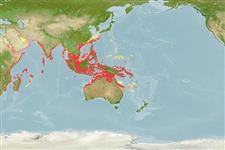>
Eupercaria/misc (Various families in series Eupercaria) >
Lutjanidae (Snappers) > Lutjaninae
Etymology: Lutjanus: Malay, ikan lutjan, name of a fish.
More on author: Bloch.
Environment: milieu / climate zone / depth range / distribution range
Écologie
marin récifal; profondeur 0 - 96 m (Ref. 57178). Tropical; 32°N - 26°S, 31°E - 165°E (Ref. 55)
Indo-West Pacific: East Africa to the Solomon Islands, north to southern Japan, south to Australia. Recently recorded from Tonga (Ref. 53797). Usually referred to as Lutjanus lineolatus by previous authors.
Length at first maturity / Taille / Poids / Âge
Maturity: Lm 12.2, range 11 - 24.6 cm
Max length : 35.0 cm TL mâle / non sexé; (Ref. 5450); âge max. reporté: 11 années (Ref. 55)
Épines dorsales (Total) : 10 - 12; Rayons mous dorsaux (Total) : 12; Épines anales: 3; Rayons mous anaux: 8. Dorsal profile of head gently sloped. Preorbital bone very narrow, much less than eye diameter. Preopercular notch and knob poorly developed. Scale rows on back rising obliquely above lateral line. Generally silvery white, with a broad yellow stripe running along the side from the eye to the caudal fin base. A series of faint narrow yellow horizontal lines is on the lower half of the body. The fins are pale yellow to whitish (Ref. 469). Body depth 2.9-3.3 in SL (Ref. 90102).
Adults inhabit offshore coral reefs and trawling grounds. Trawled to depth of almost 100 m (Ref. 48635). Frequently encountered in large schools with other Lutjanus species (Ref. 9710). Feed on fishes and crustaceans (Ref. 30573).
Allen, G.R., 1985. FAO Species Catalogue. Vol. 6. Snappers of the world. An annotated and illustrated catalogue of lutjanid species known to date. FAO Fish. Synop. 125(6):208 p. Rome: FAO. (Ref. 55)
Statut dans la liste rouge de l'IUCN (Ref. 130435)
Menace pour l'homme
Harmless
Utilisations par l'homme
Pêcheries: hautement commercial
Outils
Articles particuliers
Télécharger en XML
Sources Internet
Estimates based on models
Preferred temperature (Ref.
123201): 24.9 - 29.1, mean 28.1 °C (based on 1914 cells).
Phylogenetic diversity index (Ref.
82804): PD
50 = 0.5000 [Uniqueness, from 0.5 = low to 2.0 = high].
Bayesian length-weight: a=0.01622 (0.01061 - 0.02479), b=2.95 (2.83 - 3.07), in cm total length, based on LWR estimates for this species & Genus-body shape (Ref.
93245).
Niveau trophique (Ref.
69278): 4.1 ±0.62 se; based on food items.
Résilience (Ref.
120179): Milieu, temps minimum de doublement de population : 1,4 à 4,4 années (K=0.5; tmax=11).
Fishing Vulnerability (Ref.
59153): Low to moderate vulnerability (25 of 100).
Nutrients (Ref.
124155): Calcium = 43.5 [28.8, 60.1] mg/100g; Iron = 0.375 [0.238, 0.560] mg/100g; Protein = 18.6 [17.1, 19.9] %; Omega3 = 0.153 [0.109, 0.211] g/100g; Selenium = 63.6 [42.8, 92.8] μg/100g; VitaminA = 145 [28, 534] μg/100g; Zinc = 0.451 [0.360, 0.629] mg/100g (wet weight); based on
nutrient studies.
